-
No-Code
Platform
-
Studio
No-code agentic platform delivering the fastest time-to-value and the highest ROI
-
Studio
-
AI-Native CRM
CRM
-
AI-Native CRM
New era CRM to manage customer & operational workflows
CRM Products -
AI-Native CRM
- Industries
- Customers
- Partners
- About
Switch Fast. Scale Smart. Go Creatio

Mendix is a great low-code application development solution that enables users to build mobile and web applications at scale. It boasts a wide range of functionalities, however, some businesses are prompted to seek Mendix alternatives that are more accessible to nontechnical developers or offer better pricing options.
In this article, we explain what to look for in a Mendix competitor and go through 10 platforms that outperform Mendix in one way or another.
What is Mendix?
Mendix is a low-code platform for building and deploying enterprise-grade applications. It offers visual development tools through a desktop-based visual app-modeling IDE (integrated development environment) which seamlessly integrates with other coding IDEs.
Mendix caters to fusion teams consisting of professional developers and knowledge workers without an IT background. It provides a platform for process automation through Mendix Workflow, an integrated capability that allows business users to develop process-based enterprise apps of varying complexities using drag-and-drop elements.
In addition to its workflow capabilities, Mendix provides its own design system tailored for creating reusable assets for UI development.
All in all, Mendix is designed to accelerate the entire application development lifecycle, from ideation and development to deployment and operations.
Why Consider Alternatives to Mendix?
While Mendix serves as a powerful platform for development, it does have certain limitations and functionality gaps that Mendix competitors do not. Let us look at the reasons behind considering Mendix alternatives in detail.
Mendix is designed primarily for technical developers to accelerate application development, so its interface and toolset may be too complex for citizen developers i.e., business users without technical skills. In 2023, Mendix retired its citizen developer IDE and merged it with the professional one, indicating the future focus on fusion teams rather than single citizen developers. Such focus makes the tool inaccessible to knowledge workers and complicates the development process due to the need for collaboration between business users and developers.
In addition to that, for those looking for front-office automation capabilities in their low-code platform, Mendix lacks out-of-the-box solutions, requiring users to integrate with third-party CRM systems. This integration can increase the total cost of ownership and create additional data silos, potentially complicating the application ecosystem.
According to some analysts, Mendix gives significant preference to limited business verticals such as finance and manufacturing. Organizations operating in other industries may find that Mendix does not fully meet their specific needs or requirements.
Mendix offers four editions with varying pricing tiers and additional costs for add-ons such as storage, application environments, and support. This pricing model somewhat lacks the flexibility to satisfy the broader spectrum of client sizes and use cases. For organizations seeking a more flexible pricing model without additional costs, exploring alternative platforms could be advantageous.
What Should You Look for in a Mendix Alternative?
Let's explore the features necessary in a Mendix alternative that mirrors its strengths while eliminating its weaknesses.
- Functional scope: Look for a Mendix alternative that encompasses essential low-code capabilities and a composable UI, i.e. the ability to design custom UI from prebuilt elements. Make sure it provides the necessary tools for your specific use case, such as visual development tools, reusable components, data integration, collaboration features, and more.
- Accessibility: If you're seeking a user-friendly solution, avoid platforms that bundle complex tools that are meant for professional developers and come with additional costs. Check the user interface and how intuitive it is for both developers and business users.
- Customization: Look for the Mendix alternative that allows you to easily adapt its features and look to your business needs. This ensures that no matter what industry your company operates in, you'll be able to utilize the full potential of the low-code platform.
- Integration: Evaluate the integration capabilities of the low-code platform. It should seamlessly adapt to your existing IT ecosystem and facilitate data exchange across various tools for enhanced convenience.
- Governance: Seek a quality Mendix alternative equipped with robust and easy-to-use governance tools that ensure efficient and secure low-code development practices.
- Ease of deployment: Deployment of low-code software often requires customization and training. Make sure the vendor provides deployment support such as consultations and learning material before you opt-in for a platform.
- Customer support and training: Evaluate the responsiveness of customer support managers and the comprehensiveness of learning materials provided by the vendor before investing in a solution.
- Pricing: Focus on platforms offering unbundled pricing options to avoid hidden costs and prioritize transparent pricing structures to facilitate better budget planning.
These criteria can help you find a Mendix alternative that fits your organization's requirements and maximizes productivity while minimizing unnecessary costs and time spent on deployment.
10 Best Mendix Alternatives to Choose in 2026
One of the Mendix's downsides is its complexity for citizen developers i.e. knowledge workers who don't possess coding skills. In this round up we wanted to highlight both low-code and no-code platforms to present Mendix alternatives with the various grades of accessibility for non-programmers. Let's start the list with a no-code solution that doesn't require programming expertise.
1. Creatio
Creatio is the best Mendix alternative for companies looking for an all-in-one low-code/no-code platform for CRM, workflow automation and application development.
In the most recent The Forrester Wave™: Low-Code Development Platforms For Professional Developers report Creatio was named a sole Leader, highlighting it as a leading option for enterprises that want well-governed citizen development and superior automation at scale.
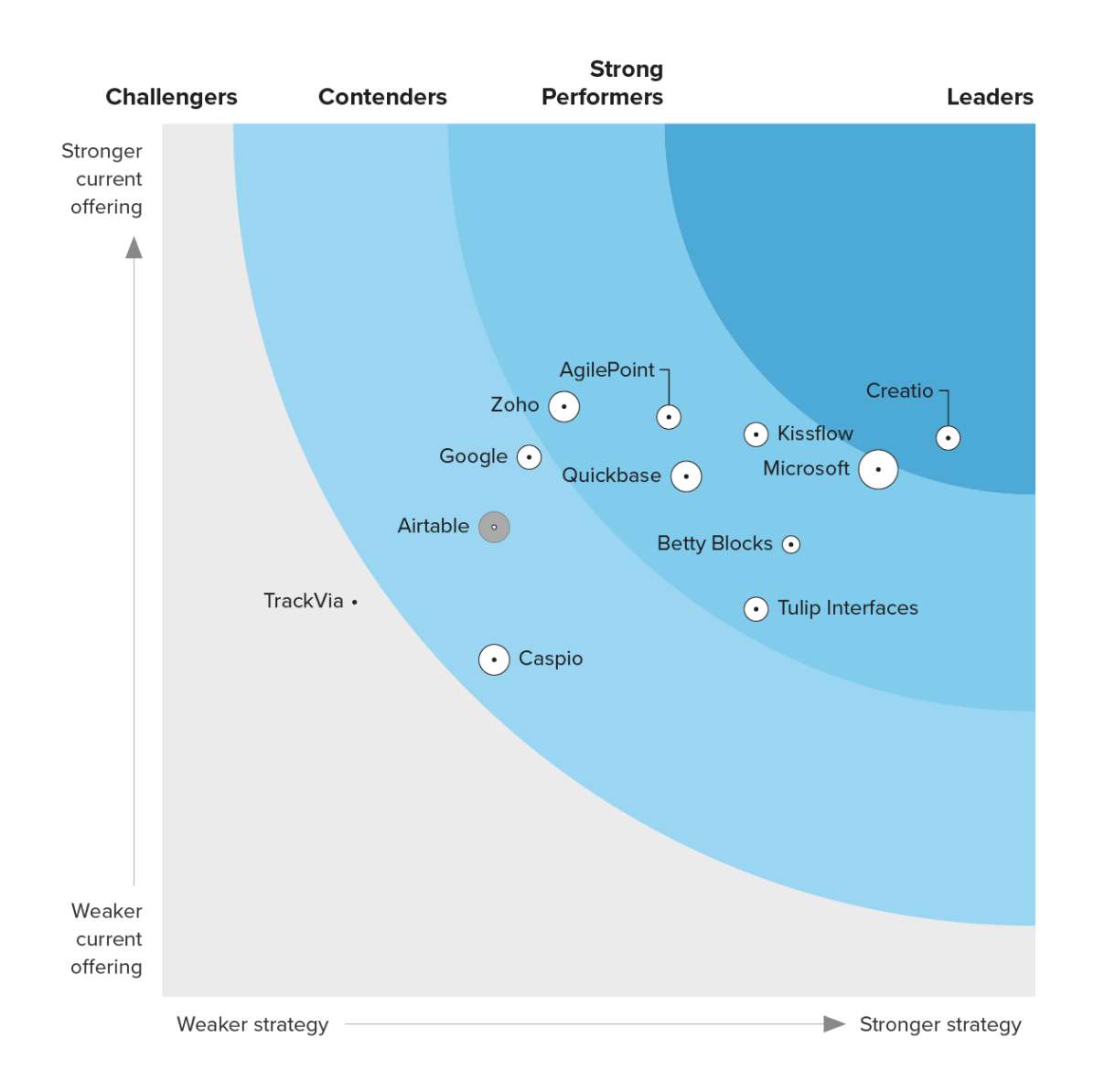
The no-code capabilities are supported by Creatio Studio's composable architecture, which breaks down all its ready-made apps into reusable components that you can drag and drop to build new programs. The components represent specific actions, buttons, data fields, forms, and everything else you need to build a business application. In addition to that, Creatio employs AI to assist you with no-code development, making it even more accessible to non-programmers.

Creatio provides flexible and intuitive UI, which enables you to build workflow automations and apps with ease. In addition to that, the governance module provides 100-plus recommended policy configurations out of the box. Users also get access to features for documenting, versioning, auditing, and enforcing custom policies with the platform’s superior automation tools.
The Creatio Marketplace offers an extensive collection of over 700 applications, enhancing the capabilities of your no-code development platform.
Creatio's offering is strengthened by its industry-recognized CRM tools, encompassing marketing, sales, and service automation, which are built on top of the Creatio Studio platform. Thanks to this unique synergy, organizations can automate a wide spectrum of customer-facing and operational business tasks, all on a single, unified platform. Additionally, Creatio offers full-featured solutions for 20 different industries.
Creatio offers one of the most transparent pricing models on the market, clearly outlining the anticipated rates without hidden fees. The entry point for Creatio Studio starts at an affordable $25 per user per month, making it a cost-effective choice for businesses of various sizes.
Ready to explore the best Mendix alternative?

2. Appian
Appian is one of the leading low-code platforms for app development, with a particular focus on dynamic case management and business processes automation. It facilitates collaboration between professional and citizen developers through embedded design studios with workflows, approvals, and change management for different developer personas.
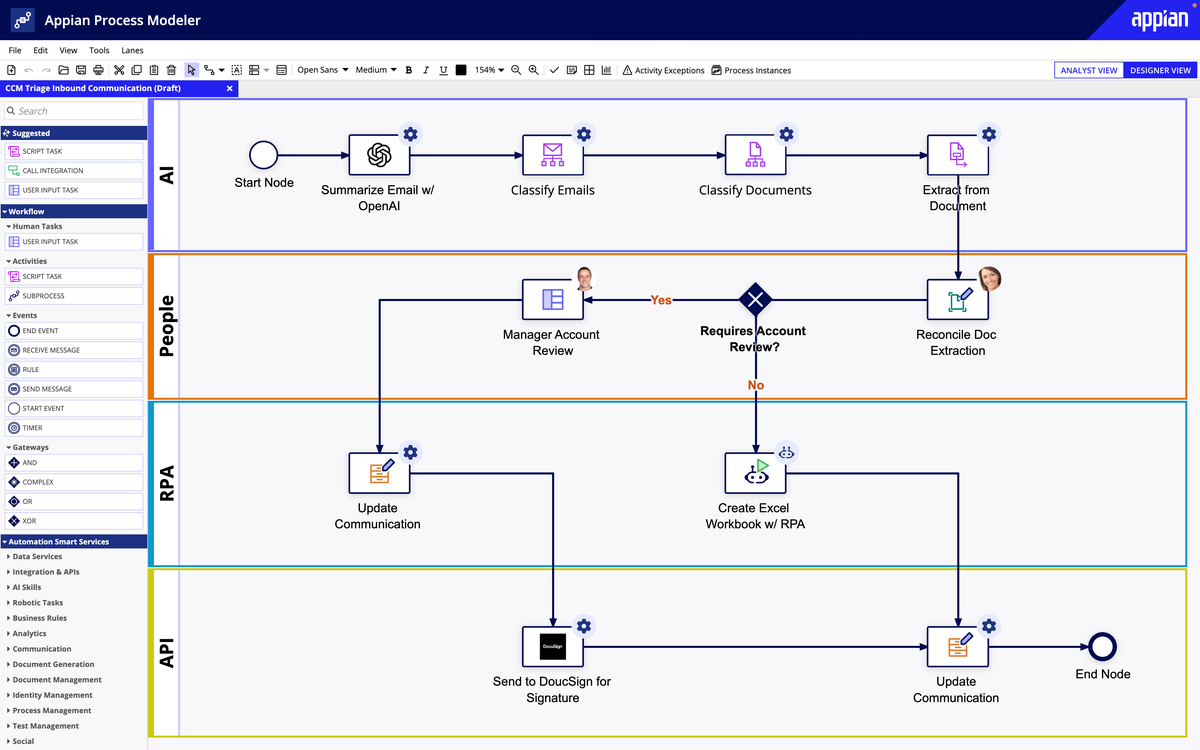
Appian holds a prominent position in the low-code industry thanks to its robust automation platform, featuring drag-and-drop elements, support for business process modeling, flexible deployment options, and modern user experience. With advanced data modeling, document management, and seamless integration, Appian emerges as a powerful solution, tailored for professional developers.
All in all, its goal is to speed up the development process without completely replacing the need for manual coding.
The pricing for Appian's platform is only available on request, which can be a drawback for users trying to research affordable low-code solutions.
See also: Top 9 Appian Competitors & Alternatives
3. Outsystems
OutSystems is a versatile low-code development tool tailored to assist businesses in crafting applications of diverse complexities. Targeted primarily at professional developers, OutSystems aims to streamline application development processes by providing them with a technical IDE and an array of features.
The platform empowers users to construct applications using modular components inside its built-in design system. It provides a library of pre-coded UI patterns, screen templates, and app templates, ensuring a uniform appearance across various applications.
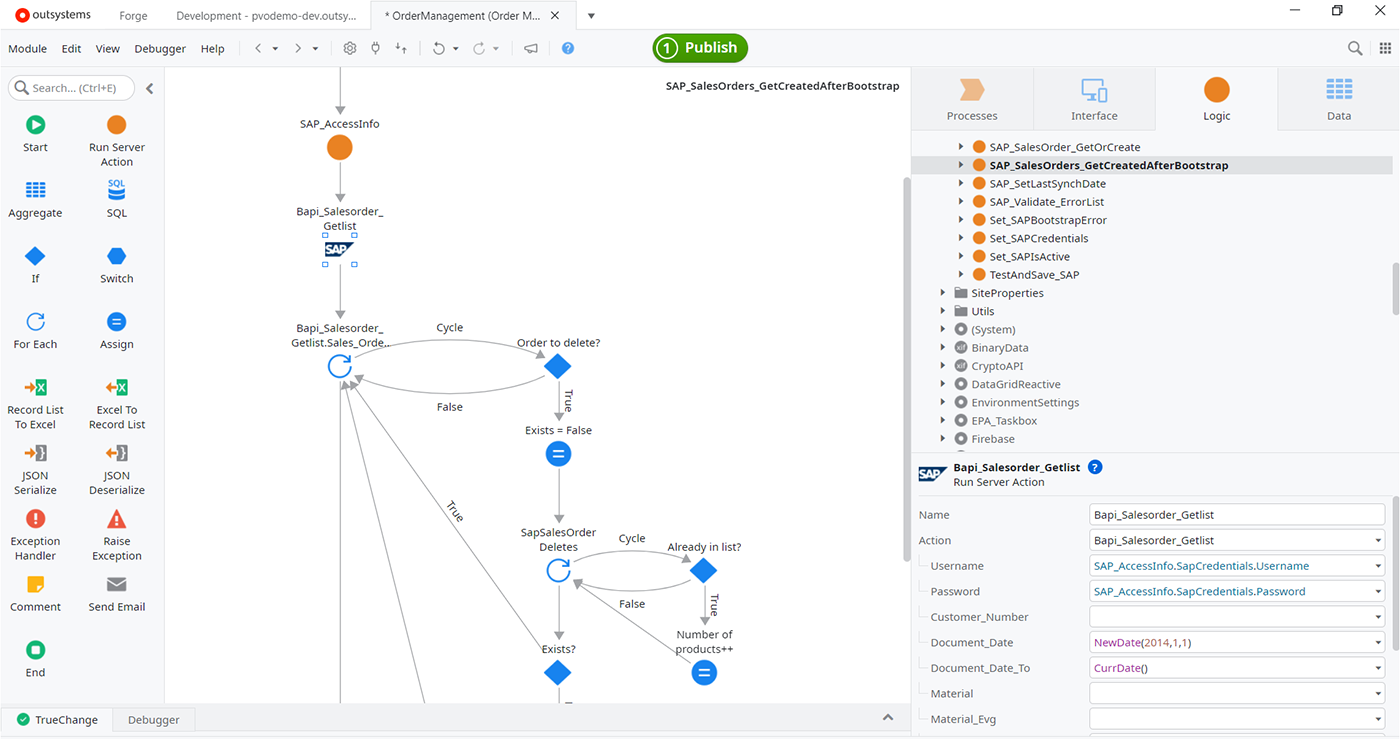
However, OutSystems lacks out-of-the-box solutions for CRM automation. Furthermore, the platform offers only rudimentary tools for modifying existing application templates and executing simple customizations, making it too complex for citizen developers.
The pricing model commences at $1,513 per month, with some customers expressing discontent regarding the cost of licenses, which can hinder the platform's expansion to address additional business cases. There's also a free version of the platform that enables you to build one application.
See also: Top 10 OutSystems Competitors & Alternatives
4. Pega
Pega is a sophisticated business process management platform renowned for its comprehensive low-code tools. It uses prebuilt app templates to expedite application development and customizations.
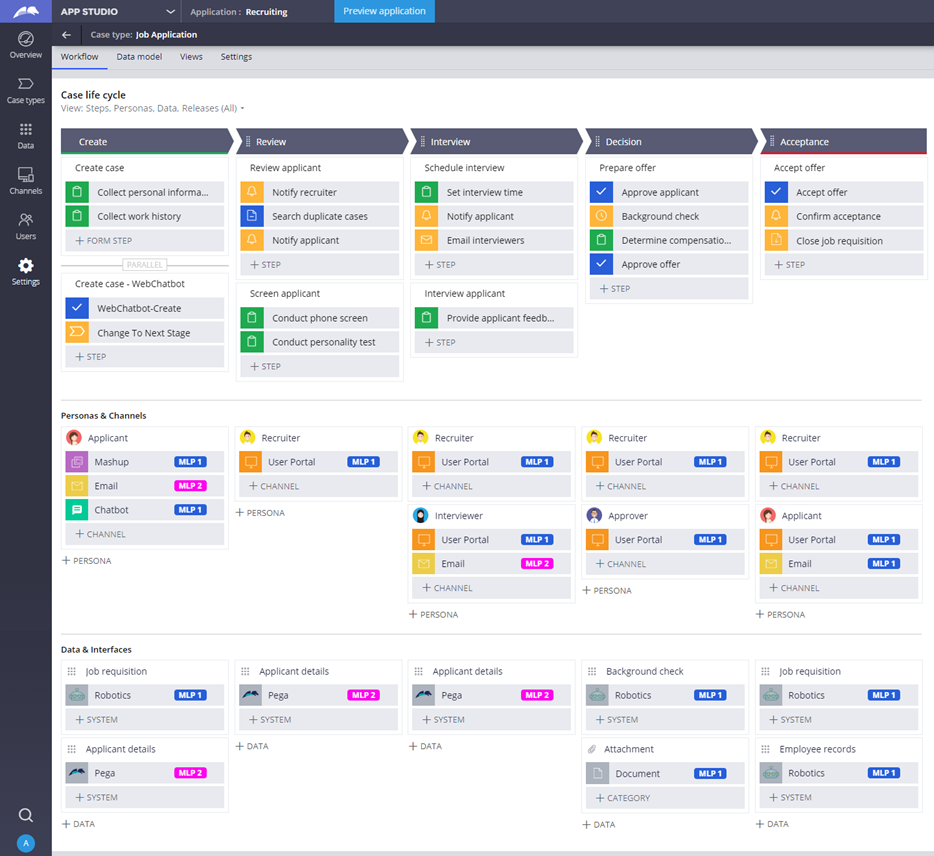
Pega boasts great digital process automation capabilities, encompassing AI-assisted development, case management, end-to-end process orchestration, and more. Noteworthy are the platform's advanced features for governance, spanning version control and Continuous Integration and Continuous Delivery (CI/CD), agile planning, and security certifications.
As per customer feedback, Pega shines particularly in handling challenging use cases, offering many instruments for modeling non-standard processes.
Reviews point out Pega's inconsistent pricing model, featuring one of the highest per-user fees in the market. Utilizing the platform entails numerous associated costs, including expenses for certified developers and service integrators.
The pricing starts at $35 per user/month, but a steep curve restricts access to some significant features, such as a comprehensive list of AI and machine learning capabilities, which are only available in the most expensive editions of Pega's platform.
See also: Top 10 Pega Alternatives and Competitors
5. Zoho Creator
Zoho is a high-quality low-code platform. The platform's capabilities are remarkably robust, offering a balance between power and accessibility for non-technical developers.
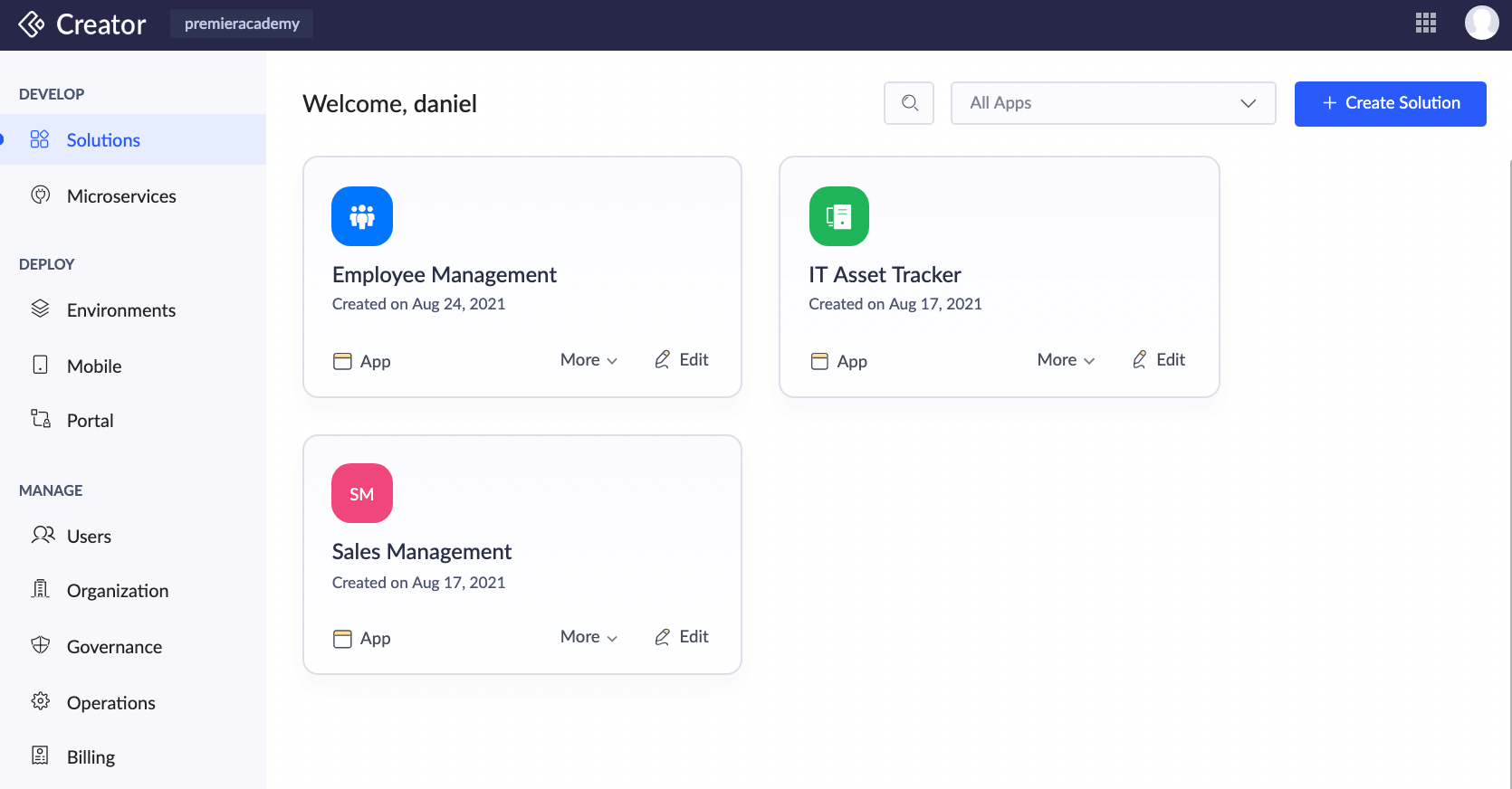
While it offers a plethora of innovative solutions such as AI-assisted development, it neglects necessary enterprise features like powerful governance tools and version control.
Zoho Creator impresses with its extensive suite of 850 integration connectors, developed and supported by Zoho itself. The platform integrates quality assurance tools in a full test automation suite. Notably, users can transition between low-code and high-code tooling.
Zoho is more affordable compared to its low-code competitors, starting at $20 per user/month, even though the starter option lacks some of the core features, such as the integration with business apps (messengers, calendars, paying systems, etc.)
6. Oracle Application Express (APEX)
Oracle APEX is a legacy low-code system that targets both professional and citizen developers. Initially, it was a complimentary tool bundled with the Oracle database, but now it's sold as a standalone low-code solution.
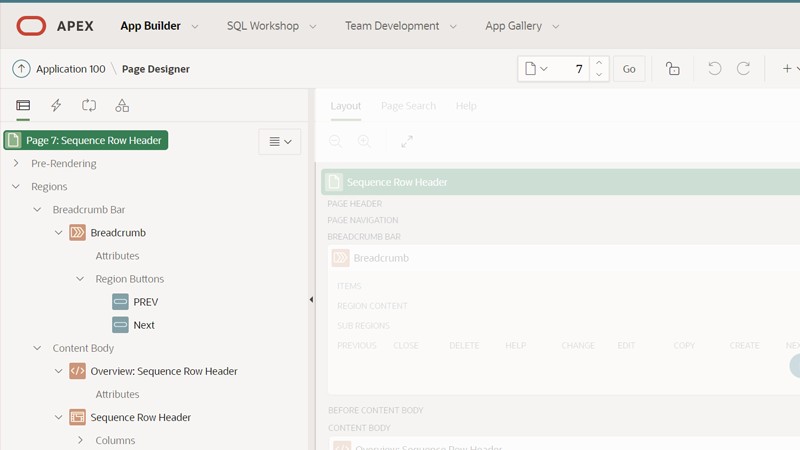
The platform shines in its robust security certifications and offers practical tools for efficiently managing a multitude of applications. It offers numerous pre-packed monitoring reports and solid governance and access controls. Professional developers highlight the platform's development speed, clean IDE UI, on-premises deployment options, and heavy reliance on Structured Query Language (SQL).
This reliance on SQL presents challenges, resulting in frustrations with complex UI development, lack of version control, limited mobile features, and exclusive support for the Oracle database. Moreover, despite fostering a sizable developer community, the platform marketplace remains relatively modest.
Oracle APEX offers a uniquely simple pricing model. Users are not charged by the number of app users, developers, or apps. Instead, they pay for compute and storage consumed by the APEX apps. The pricing starts at $122 per month. There's also a free version available that allows you to create one application.
Oracle APEX is a viable option for organizations with numerous SQL developers who prioritize a straightforward and scalable commercial model above all else.
7. Microsoft Power Apps
Microsoft aims to enable collaboration between low-code and high-code developers on its enterprise stack with the help of its AI development assistant, Copilot.
Its professional tools for UX functionality development, data management, integration (1,100 connectors), testing, and coding, are excellent, with security practices on par.
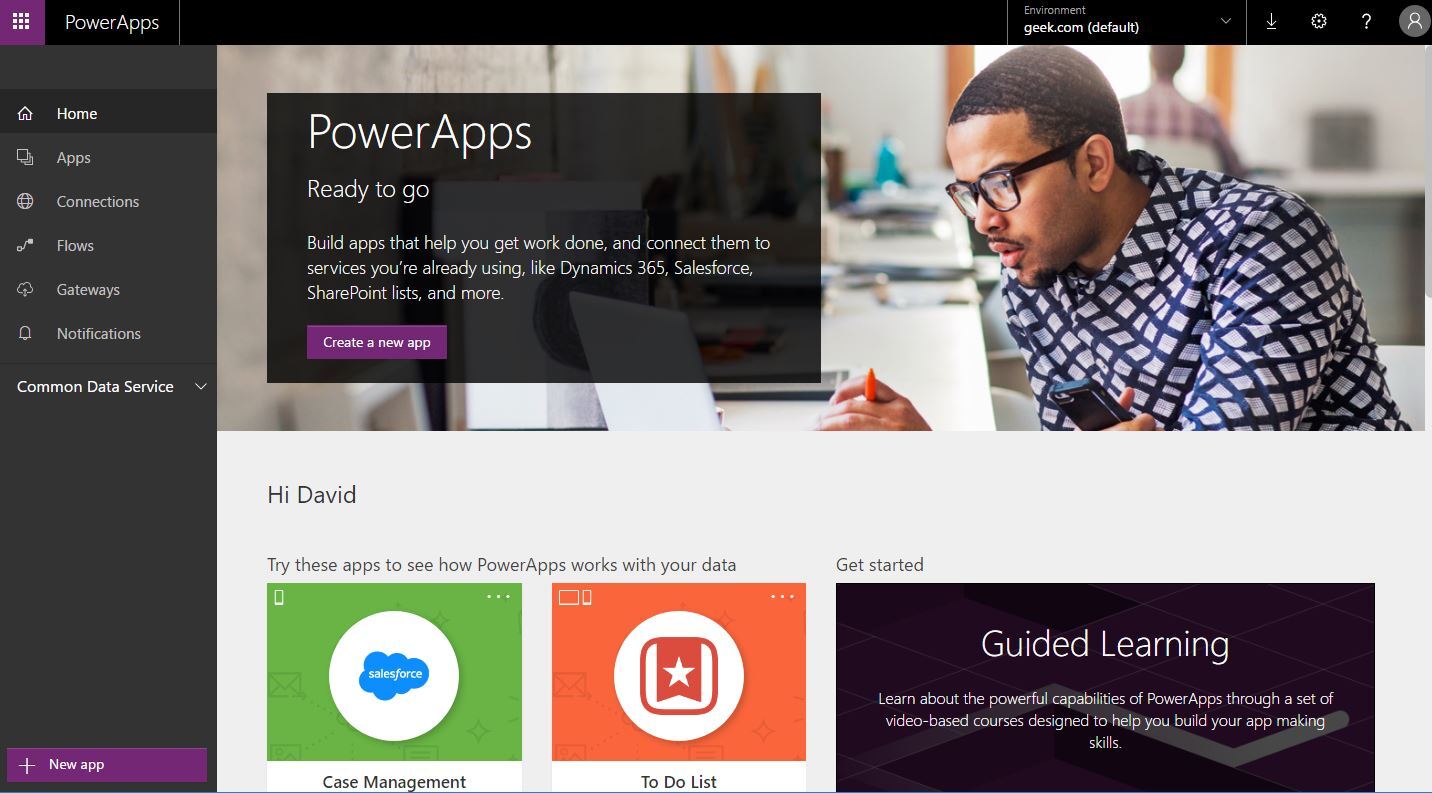
However, Microsoft Power Apps’ offering for citizen developers is not as strong. For example, its UI development features rely on technical FX language developed by Microsoft.
Some reviews also mention the complexity of Microsoft overall platform — customers find it challenging to understand all the various subproducts and their added-up costs. The pricing for the core platform starts at $20 per user/month.
8. ServiceNow
ServiceNow, rooted in service management, has evolved to encompass business process automation and low-code decentralized development, earning recognition as one of the most comprehensive systems of record for IT among its user bases.
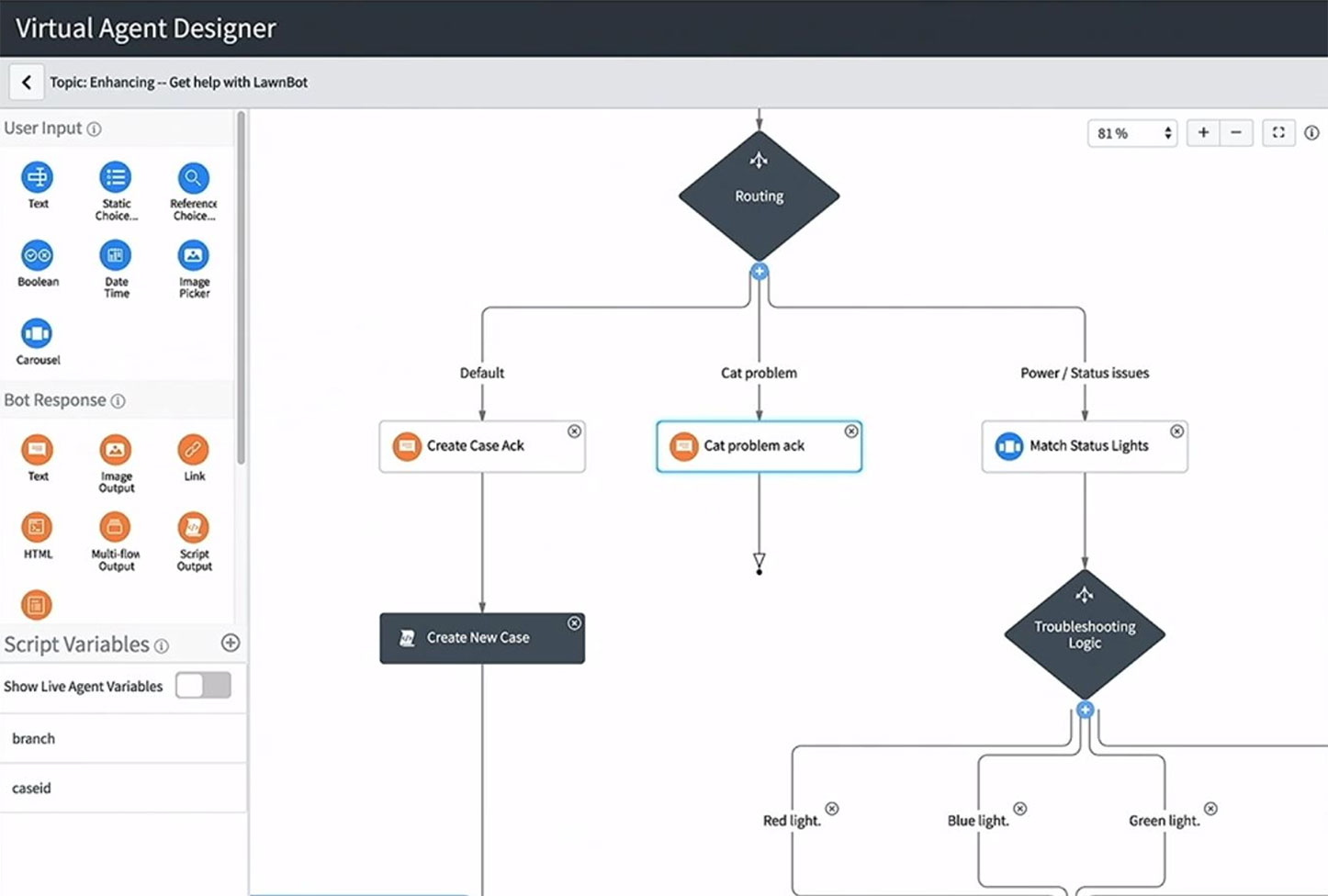
ServiceNow provides exceptional out-of-the-box features for low-code development and robust app management. Users praise its governance approach that aligns seamlessly with common DevOps practices.
The platform's integration capabilities stand out, boasting over 600 connectors that offer extensive opportunities for building and expanding your IT ecosystem.
However, ServiceNow faces criticism for its opaque pricing structure. Costs are not readily visible on the website, and according to reviews, customers often encounter hidden fees even with the highest-paying plans.
For businesses seeking robust enterprise-level workflow automation, ServiceNow is an excellent option, particularly if they are open to investing in professional developers to harness its capabilities.
9. Salesforce Lightning
Salesforce's Lightning is a CRM platform with low-code capabilities, so many of its customers choose it first and foremost for its CRM capabilities. The vendor targets both professional and citizen developers, with a slight preference to the former, and there's a strong community of Salesforce developers on the market.
Salesforce's low-code capabilities are extensive, catering to a wide range of industries and integration needs, particularly targeting midsize to large enterprises. The platform seamlessly integrates low-code development features with its industry-specific cloud solutions and boasts an expansive marketplace housing over 7,000 resources.
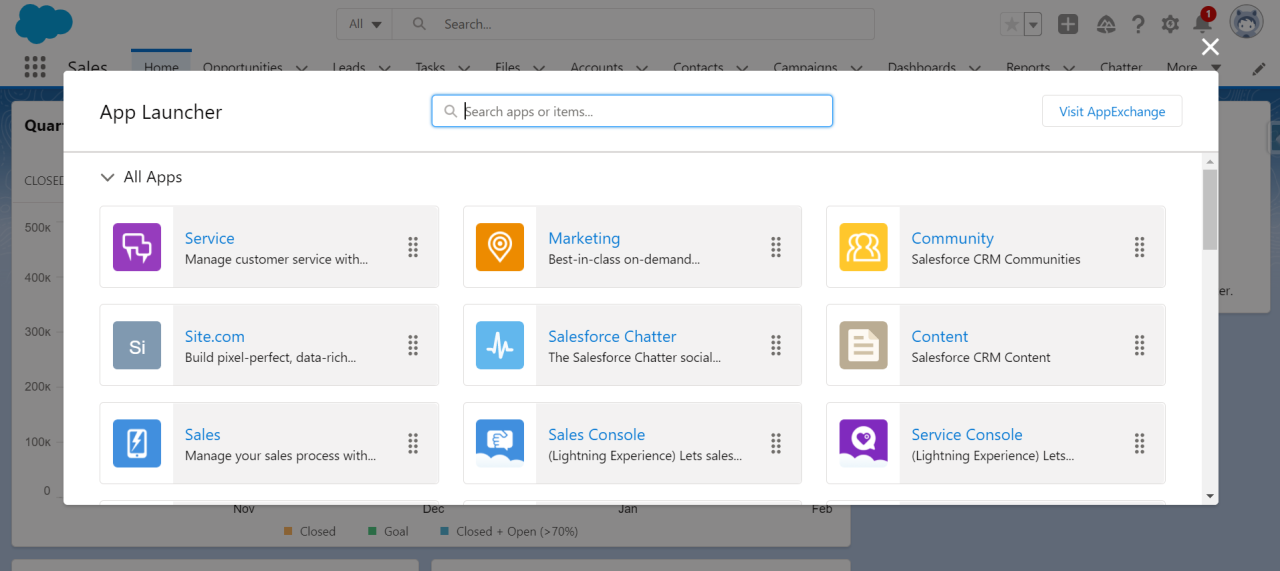
However, navigating the Salesforce Platform is challenging. Users report that the platform is intricate, demanding, and requires substantial coding proficiency to figure out its various configuration frameworks tailored for distinct use cases.
In terms of pricing, the Salesforce Platform offers tiered plans starting at $25 per user per month, offering limited capabilities, and scaling up to $500 for the most comprehensive solution tailored for large enterprises. This pricing structure fits businesses with substantial budgets.
Salesforce customers, especially those with existing app investments, should primarily consider it for development in and around their established ecosystem.
See also: Salesforce Alternatives & Competitors and Salesforce Marketing Cloud Alternatives & Competitors
10. Unqork
Unqork is a no-code platform focused on financial industries, healthcare, and government sectors. It provides a completely visual development platform for cross-functional teams consisting of IT and business specialists.
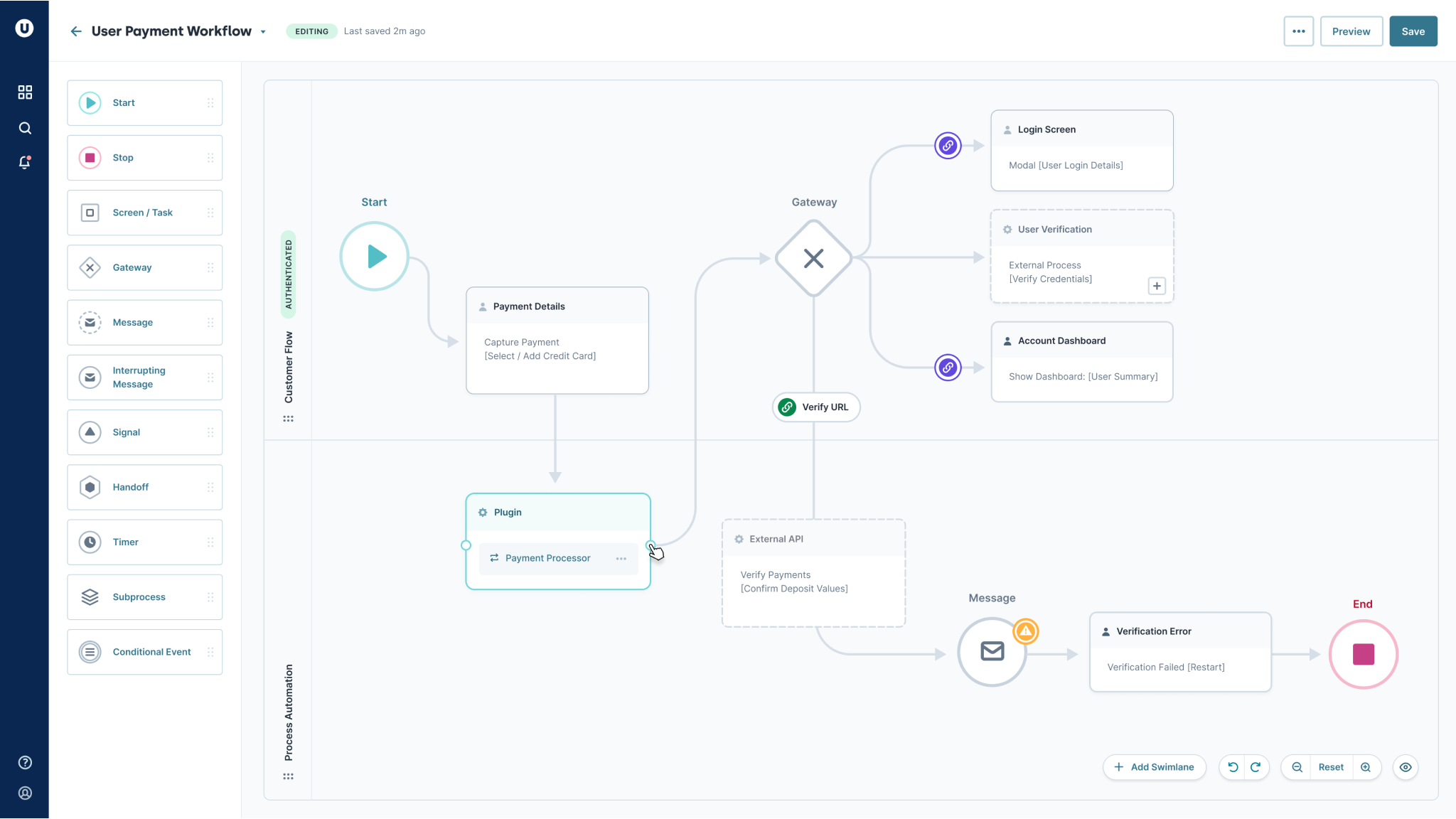
The platform gives you drag-and-drop components that automatically validate and monitor other components to build complex interactions. Reviews also praise UX development tools, featuring numerous style settings, and as well as workflow automation capabilities.
However, Unqork lacks a vast out-of-the-box feature set and its list of pre-made connectors remains limited, resulting in below-par integration features.
Organizations should consider Unqork if they are within Unqork's target industries and are prioritize composability.
In Conclusion
Each platform on this list has its advantages and disadvantages.
When seeking alternatives to Mendix, businesses must weigh the focus on non-technical versus technical developers and prioritize governance, operational power, and a user-friendly UI to enhance productivity and streamline application development processes.
For businesses in search of an accessible no-code solution, Creatio emerges as a clear leader, as corroborated by the Forrester report. Experience the platform's offerings firsthand by signing up for a free trial of Creatio.





















































